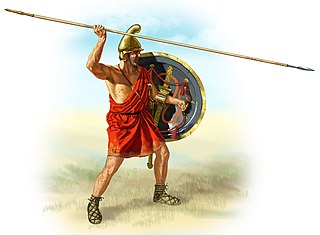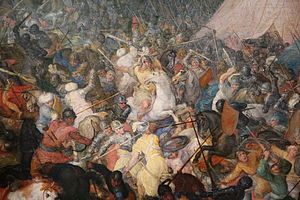
Darius III was the last Achaemenid King of Kings of Persia, reigning from 336 BC to his death in 330 BC.
This article concerns the period 339 BC – 330 BC.

The Battle of Gaugamela, also called the Battle of Arbela, took place in 331 BC between the forces of the Army of Macedon under Alexander the Great and the Persian Army under King Darius III. It was the second and final battle between the two kings, and is considered to be the final blow to the Achaemenid Empire, resulting in its complete conquest by Alexander.

The wars of Alexander the Great were a series of conquests that were carried out by Alexander III of Macedon from 336 BC to 323 BC. They began with battles against the Achaemenid Persian Empire, then under the rule of Darius III of Persia. After Alexander's chain of victories against Achaemenid Persia, he began a campaign against local chieftains and warlords that stretched as far from Greece as the region of Punjab in South Asia. At the time of his death, he ruled over most regions of Greece and the conquered Achaemenid Empire ; he did not, however, manage to conquer the Indian subcontinent in its entirety according to his initial plan. Despite his military accomplishments, Alexander did not provide any stable alternative to the rule of the Achaemenid Empire, and his untimely death threw the vast territories he conquered into a series of civil wars, commonly known as the Wars of the Diadochi.

The Battle of the Hydaspes also known as Battle of Jhelum, or First Battle of Jhelum, was fought between Alexander the Great and Porus in May of 326 BC. It took place on the banks of the Hydaspes River in Punjab, as part of Alexander's Indian campaign. In what was possibly their most costly engagement, the Macedonian army secured a decisive victory over the Pauravas and captured Porus. Large areas of Punjab were subsequently absorbed into the Macedonian Empire; Porus was reinstated as the region's ruler after Alexander, having developed a newfound respect for the fierce resistance put up by Porus and his army, appointed him as a satrap.
Meleager was a Macedonian officer who served under Alexander the Great.

The Battle of the Granicus in May 334 BC was the first of three major battles fought between Alexander the Great of Macedon and the Persian Achaemenid Empire. The battle took place on the road from Abydus to Dascylium, at the crossing of the Granicus in the Troad region, which is now called the Biga River in Turkey. In the battle Alexander defeated the field army of the Persian satraps of Asia Minor, which defended the river crossing. After this battle, the Persians were forced on the defensive in the cities that remained under their control in the region.
Parmenion, son of Philotas, was a Macedonian general in the service of Philip II of Macedon and Alexander the Great. A nobleman, Parmenion rose to become Philip's chief military lieutenant and Alexander's strategos. He was assassinated after his son Philotas was convicted on a charge of treason. His siblings Asander and Agathon would also become prominent members of Alexander's Macedonia.

The army of the Kingdom of Macedon was among the greatest military forces of the ancient world. It was created and made formidable by King Philip II of Macedon; previously the army of Macedon had been of little account in the politics of the Greek world, and Macedonia had been regarded as a second-rate power.
The pezhetairoi were the backbone of the Macedonian army and Diadochi kingdoms. They were literally "foot companions".
Nicanor, son of Parmenion, was a distinguished officer in the service of Alexander the Great. He is first mentioned at the passage of the Danube river, in the expedition of Alexander against the Getae in 335 BC, when he led the phalanx. During the expedition into Asia, he appears to have uniformly held the chief command of the body of troops called the Hypaspists (υπασπισται) shield-bearers or foot-guards, numbering three units of 1,000 men. As his brother Philotas did that of the εταιρoι, or horse-guards. We find him mentioned, as holding this post, in the three great battles of the Granicus, Issus, and Gaugamela. He afterwards accompanied Alexander with a part of the troops under his command, during the rapid march of the king in pursuit of the king Darius III in 330 BC; which was probably his last service, as he died of disease shortly afterwards, during the advance of Alexander into Bactria. His death at this juncture was considered a fortunate event, as it prevented him from participating either in the designs or the fate of his brother Philotas.

The Battle of the Persian Gate was a military conflict between a Persian force, commanded by the satrap of Persis, Ariobarzanes, and the invading Hellenic League, commanded by Alexander the Great. In the winter of 330 BC, Ariobarzanes led a last stand of the outnumbered Persian forces at the Persian Gates near Persepolis, holding back the Macedonian army for a month. Alexander eventually found a path to the rear of the Persians from the captured prisoners of war or a local shepherd, defeating the Persians and capturing Persepolis.
Pharnabazus III was a Persian satrap who fought against Alexander the Great. His father was Artabazos II, and his mother a Greek from Rhodes.
Amyntas, son of Antiochus, was a Macedonian general, fugitive and traitor. As officer of Philip II, he and Amyntas were awarded proxenies by the Oropians in Boeotia before 338 BC. After the death of Philip II, Amyntas fled from Macedonia. Arrian ascribes his flight from Macedonia to his hatred and fear of Alexander the Great; the ground of these feelings is not stated, but Mitford connects him with the plot of Pausanias of Orestis and the murder of Philip. He took refuge in Ephesus under Persian protection; whence, however, after the battle of the Granicus, fearing the approach of Alexander, he escaped with the Greek mercenaries who garrisoned the place, and fled to the court of Darius. In the winter of the same year, 333 BC, while Alexander was at Phaselis in Lycia, discovery was made of a plot against his life, in which Amyntas was implicated. He appears to have acted as the channel through whom Darius had been negotiating with Alexander of Lyncestis, and had promised to aid him in mounting the Macedonian throne on condition of assassinating Alexander. The design was discovered through the confession of Asisines, a Persian, whom Darius had despatched on a secret mission to the Lyncestian, and who was apprehended by Parmenion in Phrygia.

The Battle of Alexander at Issus is a 1529 oil painting by the German artist Albrecht Altdorfer, a pioneer of landscape art and a founding member of the Danube school. The painting portrays the 333 BC Battle of Issus, in which Alexander the Great secured a decisive victory over Darius III of Persia and gained crucial leverage in his campaign against the Persian Empire. The painting is widely regarded as Altdorfer's masterpiece, and is one of the most famous examples of the type of Renaissance landscape painting known as the world landscape, which here reaches an unprecedented grandeur.
Arsames was an Achaemenid Persian satrap of Cilicia in 334/3 BC. He succeeded Mazaeus in this position. He took part in the Battle of the Granicus where he fought with his cavalry on the left wing, along with Arsites and Memnon of Rhodes. He was able to survive that battle and flee to the capital of Cilicia Tarsus. There, he was planning a scorched-earth policy according to that of Memnon which caused the native Cilician soldiers to abandon their posts. He also decided to burn Tarsus to the ground so as not to fall in the hands of Alexander but was prevented from doing so by the speedy arrival of Parmenion with the light armored units who took the city. After that, Arsames fled to Darius III who was at this time in Syria. He was slain at the Battle of Issus in 333 BC.
Parysatis, the youngest daughter of Artaxerxes III of Persia, married Alexander the Great in 324 BC at the Susa weddings. She may have been murdered by Alexander's first wife, Roxana, in 323 BC.

Sabaces was an Achaemenid Persian satrap of the Achaemenid Thirty-first Dynasty of Egypt during the reign of king Darius III of Persia.
Atizyes was a Persian satrap of Greater Phrygia under the Achaemenids in 334 BC, when Alexander the Great began his campaign. He is not mentioned in the council of Zelea where the satrap coalition was formed against the invasion, so it is not sure whether he took part in the Battle of the Granicus. After the battle, he appears to be in the capital of Greater Phrygia, Celaenae where he had a garrison force of 1,000 Carians and 100 Greek mercenaries. He himself went to Syria to join the army of Darius III and was killed during the Battle of Issus in November 333 BC. After Phrygia fell to Alexander, he appointed his general Antigonus Monophthalmus as its satrap.
The military tactics of Alexander the Great show that he was one of the greatest generals in history. During the Battle of Chaeronea, won against the Athenian and Theban armies, and the battles of Granicius and of Issus, won against the Achaemenid Persian army of Darius III, Alexander employed the so-called "hammer and anvil" tactic. However, in the Battle of Gaugamela, the Persians possessed an army vastly superior in numbers to the Macedonian army. This tactic of encirclement by rapid shock units was not very feasible. Alexander had to compose and decide on an innovative combat formation for the time; he arranged his units in levels; he pretended to want to encircle the enemy in order to better divide it and thus opened a breach in its defensive lines.





















